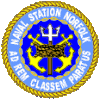Naval Station Norfolk
| Naval Station Norfolk | |
|---|---|
| Part of Navy Region Mid-Atlantic | |
| Norfolk, Virginia in the United States | |

USS John F. Kennedy (CV-67) arriving at Naval Station Norfolk, 2002
|
|
| Type | Naval Base |
| Site information | |
| Owner |
|
| Operator |
|
| Open to the public |
No |
| Site history | |
| Built | July 4, 1917 |
| In use | 1917 - present |
| Garrison information | |
| Current commander |
CAPT Douglas J. Beaver, USN |
| Occupants |
Commander, Navy Region Mid-Atlantic Commander, Navy Warfare Development Command |
Chambers Field Naval Station Norfolk |
|||||||||||
|---|---|---|---|---|---|---|---|---|---|---|---|

Air Force One landing at Chambers Field
|
|||||||||||
| Summary | |||||||||||
| Airport type | Military: Naval Air Station | ||||||||||
| Operator |
|
||||||||||
| Location | Naval Station Norfolk, Norfolk, Virginia, U.S. | ||||||||||
| Built | October 1917 | ||||||||||
| In use | 1917-present | ||||||||||
| Occupants | Naval Air Forces Atlantic | ||||||||||
| Coordinates | 36°56.7′N 76°18.8′W / 36.9450°N 76.3133°WCoordinates: 36°56.7′N 76°18.8′W / 36.9450°N 76.3133°W | ||||||||||
| Runways | |||||||||||
|
|||||||||||
|
Source: AirNav
|
|||||||||||
Naval Station Norfolk (IATA: NGU, ICAO: KNGU, FAA LID: NGU), is a United States Navy base in Norfolk, Virginia. It supports naval forces in the United States Fleet Forces Command, those operating in the Atlantic Ocean, Mediterranean Sea, and Indian Ocean. NS Norfolk, also known as the Norfolk Naval Base, occupies about four miles (6 km) of waterfront space and seven miles (11 km) of pier and wharf space of the Hampton Roads peninsula known as Sewell's Point. It is the world's largest naval station, supporting 75 ships and 134 aircraft alongside 14 piers and 11 aircraft hangars, and houses the largest concentration of U.S. Navy forces. Port Services controls more than 3,100 ships' movements annually as they arrive and depart their berths.
Air Operations conducts over 100,000 flight operations each year, an average of 275 flights per day or one every six minutes. Over 150,000 passengers and 264,000 tons of mail and cargo depart annually on Air Mobility Command (AMC) aircraft and other AMC-chartered flights from the airfield's AMC Terminal.
The land on which the naval station is located was originally the site of the 1907 Jamestown Exposition. During this exposition, high-ranking naval officers agreed that this site was ideal for a naval activity. A bill was passed in 1908 proposing that the U.S. Congress allow $1 million for the purchase of the property and buildings, but it died when the Assistant Secretary of the Navy was given a choice between this property and a new coal ship. He replied that a new ship was an absolute necessity. However, immediately after the United States entered World War I in April 1917, the Secretary of the Navy was persuaded to buy the property. A bill was passed for the purchase of 474 acres (1.9 km²); it set aside the sum of $1.2 million as payment for the property and an additional $1.6 million for the development of the base, including piers, aviation facilities, storehouses, facilities for fuel and oil storage, a recruit training station, a submarine base and recreation grounds for fleet personnel. Rear Admiral Dillingham was assigned the task of coordinating the area's development.
...
Wikipedia

